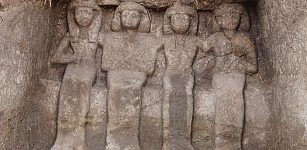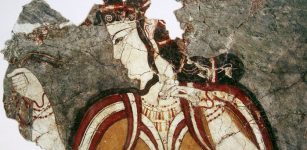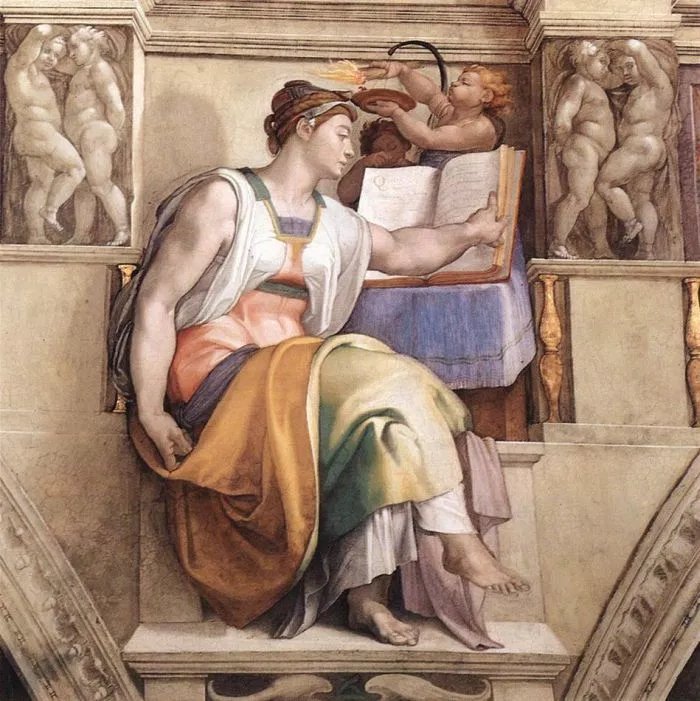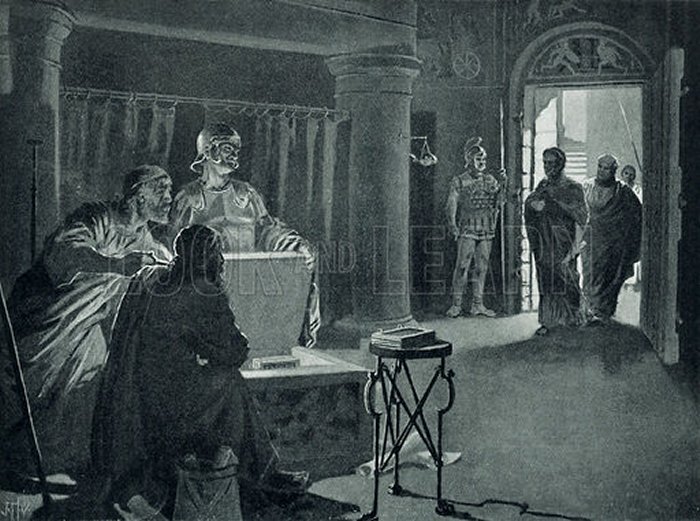Sibylline Books: Ancient Prophecies Destroyed By Fire
Ellen Lloyd - AncientPages.com - Very little is known about the original Sibylline books. The original Sibylline books were closely-guarded oracular scrolls written by prophetic priestesses (the Sibylls) in the Etruscan and early Roman Era as far back as the 6th Century B.C.E. These books were destroyed, partially in a fire in 83 B.C.E., and finally burned by order of the Roman General Flavius Stilicho (365-408 C.E.).
Who was Cumaean Sibyl?
Cumaean Sibyl was a priestess residing over the Apollonian oracle at Cumae, a Greek colony located near Naples, Italy. The word sibyl comes (via Latin) from the ancient Greek word sibylla, meaning prophetess. In the ancient world there were a number of sibyls active in various locations. Sibyls would give answers whose value depended upon good questions - unlike prophets who typically answered with responses indirectly related to questions asked.
Michelangelo's rendering of the Erythraean Sibyl.
The Cumaean Sibyl became the most famous among the Romans. In ancient Greece, the Erythraean Sibyl became well-known and the Sibyl of Dodona, possibly dating to the second millennium BC according to Herodotus, favored in the east.
Lucius Tarquinius Superbus purchases the Sibylline books
According to legend, Lucius Tarquinius Superbus the legendary seventh and final king of Rome bought the books from Cumaean Sibyl.
When Cumaean Sibyl approached Lucius Tarquinius Superbus she offered him 9 scrolls, but he didn’t want to buy them because they were too expensive.
Tarquinius tried to negotiate about the price, but Sibylle refused to sell the scrolls cheaper. Instead, she tossed three of the books into the fire.
For the six remaining books she asked the same price as she had asked for the nine books.
Lucius Tarquinius Superbus
Tarquinius was very displeased about this and made a remark about the scrolls and price. Sibylle responded again by tossing three of the books into the fire. At this point, Tarquinius got worried he would have to leave empty handed. He accepted and paid the price for three remaining although he could have had nine books for the same price.
Whether this story is true or not, remains unknown. It is possible Tarquinius invented this story to defend himself why he had paid too much for the three books.
Sibylline books were closely guarded and consulted at momentous crises
According to the Roman tradition, the oldest collection of Sibylline books appears to have been made about the time of Solon and Cyrus at Gergis on Mount Ida in the Troad. From Gergis the collection passed to Erythrae, where it became famous as the oracles of the Erythraean Sibyl. It would appear to have been this very collection that found its way to Cumae and from Cumae to Rome.
The Sibylline Books. Illustration for Hutchinson's History of the Nations (Hutchinson, c 1915).
The Roman Senate kept tight control over the Sibylline Books. The Sibylline books were closely guarded and kept in a room beneath the Temple of Jupiter on the Capitol.
In times of great dangers these books were consulted by the decemviri sacris faciundis (ten-men). The decemviri sacris faciundis held office for life, and were exempt from all other public duties. They were responsible for keeping the books in safety and secrecy.
These officials, at the command of the Senate, consulted the Sibylline Books in order to discover not exact predictions of definite future events in the form of prophecy but the religious observances necessary to avert extraordinary calamities such as for example comets and earthquakes, showers of stones and plague.
19th century illustration depicting the temple above the Tiber River during the Roman Republic.
It was only the rites of expiation prescribed by the Sibylline Books, according to the interpretation of the oracle that were communicated to the public, and not the oracles themselves, which left ample opportunity for abuses.
The Sibylline books were composed in Greek hexameter and the college of curators was always assisted by two Greek interpreters.
The destruction of the Sibylline books
When the Temple of Jupiter burned in 83 BC, they were lost. The Roman Senate sent envoys in 76 BC to replace them with a collection of similar oracular sayings, in particular collected from Ilium, Erythrae, Samos, Sicily, and Africa. This new Sibylline collection was deposited in the restored temple.
See also:
Ancient Roman Government Structure And The Twelve Tables
The Egyptian Dream Book Reveals Ancient Predictions Of The Future
From the Capitol the books were later transferred by Augustus as pontifex maximus in 12 BC, to the temple of Apollo Patrous on the Palatine. They were examined and copied and remained there until about AD 405. According to the poet Rutilius Claudius Namatianus, the general Flavius Stilicho (died AD 408) burned them, as they were being used to attack his government.
Only fragments of the Sibylline books have survived.
The Sibylline Books should not be confused with the so-called Sibylline Oracles, which contained twelve books of prophecies thought to be of Judaeo-Christian origin.
Copyright © AncientPages.com & Ellen Lloyd All rights reserved. This material may not be published, broadcast, rewritten or redistributed in whole or part without the express written permission of AncientPages.com and Ellen Lloyd
Expand for referencesMore From Ancient Pages
-
 ‘Impossible’ Ancient Knowledge Of The Gods’ Star – First Observations – Part 1
Ancient Mysteries | Aug 29, 2021
‘Impossible’ Ancient Knowledge Of The Gods’ Star – First Observations – Part 1
Ancient Mysteries | Aug 29, 2021 -
 Ancient Volcanic Eruption Was Not A Catalyst To Early Homo Sapiens Cultural Innovations – Study finds
Archaeology | Jul 8, 2024
Ancient Volcanic Eruption Was Not A Catalyst To Early Homo Sapiens Cultural Innovations – Study finds
Archaeology | Jul 8, 2024 -
 Niches With Six Figures Cut In Rock Discovered At Gebel Al-Silsila, Aswan
Archaeology | Dec 27, 2015
Niches With Six Figures Cut In Rock Discovered At Gebel Al-Silsila, Aswan
Archaeology | Dec 27, 2015 -
 You Can Visit The Tomb Of Jesus – 3D Virtual Tour Opens Soon
Archaeology | Nov 10, 2017
You Can Visit The Tomb Of Jesus – 3D Virtual Tour Opens Soon
Archaeology | Nov 10, 2017 -
 Abydos: One Of The Most Important Cities Of Ancient Egypt
Civilizations | Jul 15, 2016
Abydos: One Of The Most Important Cities Of Ancient Egypt
Civilizations | Jul 15, 2016 -
 Yuki-Onna ‘Lady Of The Snow’: A Female Demon And Symbol Of Death In Japanese Mythology
Featured Stories | Mar 7, 2019
Yuki-Onna ‘Lady Of The Snow’: A Female Demon And Symbol Of Death In Japanese Mythology
Featured Stories | Mar 7, 2019 -
 Genetic Mystery Solved: Ancient DNA Reveals Greeks Descended From The Minoans And The Mycenaeans
Archaeology | Aug 4, 2017
Genetic Mystery Solved: Ancient DNA Reveals Greeks Descended From The Minoans And The Mycenaeans
Archaeology | Aug 4, 2017 -
 Discovery At Fujiwarakyu Palace Complex Offers Better Glimpse Of 7th-Century Japan
Archaeology | Oct 21, 2015
Discovery At Fujiwarakyu Palace Complex Offers Better Glimpse Of 7th-Century Japan
Archaeology | Oct 21, 2015 -
 Greek Discovery Of Stone Tools In Megalopolis Area Pushes Back Greece’s Archaeological Record Up To 250,000 Years
Archaeology | Jun 2, 2023
Greek Discovery Of Stone Tools In Megalopolis Area Pushes Back Greece’s Archaeological Record Up To 250,000 Years
Archaeology | Jun 2, 2023 -
 Unsolved Mystery Of Gedi Ruins Protected By The ‘Old Ones’ – Why Did People Leave?
Civilizations | Apr 2, 2019
Unsolved Mystery Of Gedi Ruins Protected By The ‘Old Ones’ – Why Did People Leave?
Civilizations | Apr 2, 2019 -
 Ancient Nandivardhan Was The City Of Vakataka Rulers Who Built Ajanta Caves
Archaeology | Jun 13, 2018
Ancient Nandivardhan Was The City Of Vakataka Rulers Who Built Ajanta Caves
Archaeology | Jun 13, 2018 -
 Does This Cathedral Offer Evidence Our Calendar Is ‘Missing’ 297 Years?
Featured Stories | May 6, 2022
Does This Cathedral Offer Evidence Our Calendar Is ‘Missing’ 297 Years?
Featured Stories | May 6, 2022 -
 A 1,600-Year-Old Mosaic Accidentally Unearthed In Ancient City Of Yavne, Israel
Archaeology | Apr 26, 2021
A 1,600-Year-Old Mosaic Accidentally Unearthed In Ancient City Of Yavne, Israel
Archaeology | Apr 26, 2021 -
 Mireuksa Pagoda: Largest And One Of The Oldest Of Korean Pagodas
Archaeology | Jan 1, 2016
Mireuksa Pagoda: Largest And One Of The Oldest Of Korean Pagodas
Archaeology | Jan 1, 2016 -
 A Ptolemaic Mummy Reveals Evidence Of Dental Filling Used In Ancient Egypt
Archaeology | Aug 6, 2020
A Ptolemaic Mummy Reveals Evidence Of Dental Filling Used In Ancient Egypt
Archaeology | Aug 6, 2020 -
 On This Day In History: Twelfth Council Of Toledo Initiated By King Erwig – On Jan 9, 681
News | Jan 9, 2017
On This Day In History: Twelfth Council Of Toledo Initiated By King Erwig – On Jan 9, 681
News | Jan 9, 2017 -
 Wupatki Ruins And Sacred Sunset Crater Of Ancestral Puebloans In Arizona
Civilizations | Nov 6, 2016
Wupatki Ruins And Sacred Sunset Crater Of Ancestral Puebloans In Arizona
Civilizations | Nov 6, 2016 -
 Ruins Of 2,300-Year-Old City Of Jiaohe On The Silk Road
Civilizations | Aug 6, 2023
Ruins Of 2,300-Year-Old City Of Jiaohe On The Silk Road
Civilizations | Aug 6, 2023 -
 Did The Dogon Tribe Have Knowledge Of Theoretical Physics 5,000 Years Ago?
Ancient Mysteries | Aug 2, 2017
Did The Dogon Tribe Have Knowledge Of Theoretical Physics 5,000 Years Ago?
Ancient Mysteries | Aug 2, 2017 -
 Unknown Fragments Of Two Euripides Tragedies Found In Egyptian Grave
Scripts, Paintings & Inscriptions | Sep 9, 2024
Unknown Fragments Of Two Euripides Tragedies Found In Egyptian Grave
Scripts, Paintings & Inscriptions | Sep 9, 2024




